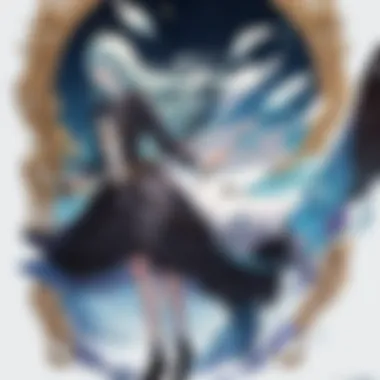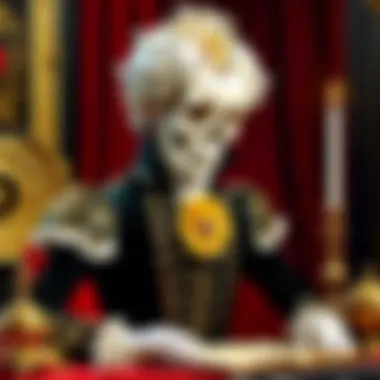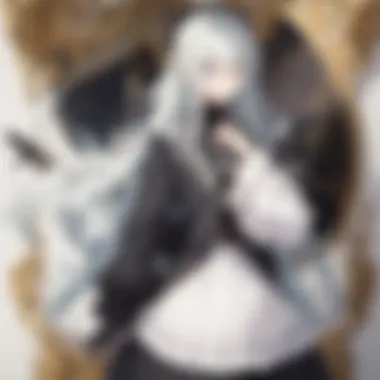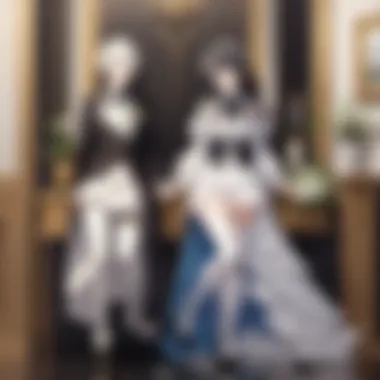Exploring Themes and Narratives in Vanitas No Carte


Intro
"Vanitas No Carte" stands as a unique entry in the realms of anime and manga, offering rich narratives and complex characters that both challenge and invite analysis. This piece will delve into the layers of meaning woven throughout the series, navigating its thematic elements and character developments while firmly rooting its analysis within the cultural currents of anime.
As anime enthusiasts increasingly seek shows that provide depth beyond entertainment, "Vanitas No Carte" emerges as a compelling study. The series not only entertains but also encourages viewers to reflect on larger societal issues, manifesting a thoughtful commentary relevant to contemporary discussions on the human experience.
Featured Series or Manga
Overview of the Series
"Vanitas No Carte," created by Jun Mochizuki, introduces viewers to a world where vampires coexist with humans, yet their fates diverge dramatically. Set in a fantastical version of 19th-century France, the narrative unfolds around a cursed book that holds immense power over vampires. The protagonist, Noé Archiviste, teams up with Vanitas, a human who possesses the book, to navigate the conflicts that ensue from its existence and the morality of its use.
The world-building is visually impactful, coupled with intricate storytelling that captures the essence of both gothic aesthetics and philosophical undertones. This duality of style and substance effectively allows for discussions on identity, morality, and the consequences of choice.
Key Characters and Development
The complexity of characters fuels the narrative arc. Noé Archiviste, with his stoic demeanor, anchors the series while grappling with his own beliefs regarding vampires. Vanitas, on the other hand, embodies the chaotic intermingling of humor and darkness, bringing a lively contrast to Noé's more serious nature. Each character undergoes substantial growth, facing personal dilemmas that resonate with viewers on various levels.
- Noé Archiviste: An innocent existence comes under threat, prompting a reevaluation of his very nature.
- Vanitas: His mischievous traits disguise deeper motivations and emotional scars connected to his past.
A key element in their development is the evolving relationship between Noé and Vanitas, reflecting themes of trust, betrayal, and the quest for understanding in a fractured world.
Character Analysis
Major Characters
In addition to the primary duo, the series presents several notable characters who contribute significantly to the storyline and thematic exploration. Each character represents diverse facets of the human and vampire experience, amplifying the series’ exploration of existential themes.
- Mitsuba: Symbolizes the tragic consequences of fate and a desperate fight for identity.
- Domi: Serves as a bridge between cultures, reflecting societal divisions and conflicts.
Character Arcs and Growth
The arcs of characters in the narrative echo the larger themes. Noé evolves from naivety toward acceptance of the complexities of the world, while Vanitas slowly reveals layers of turmoil that stem from a tumultuous past. The profound character exploration deepens the viewer’s connection with the story, illustrating that every action has ramifications, both for individuals and society.
"Every curse is born of choice; the power to change lies within." - Vanitas
Thematic Exploration
Main Themes and Messages
The central themes of "Vanitas No Carte" revolve around the struggle between light and darkness, the morality of choices, and the inherent nature of humanity. The cursed book becomes a prominent symbol of power corrupted, raising questions about morality and the repercussions of wielding such power. The narrative prompts viewers to consider their biases and assumptions.
- Identity: Characters navigate their sense of self amid societal norms and expectations.
- Morality: The fine line between right and wrong is blurred, prompting deeper introspection.
Cultural Context and Influences
The series reflects broader societal themes ingrained in contemporary anime culture. By integrating aspects of gothic literature and philosophies regarding existence, it situates itself within a rich tapestry of influences. The cultural relevance emerges through its commentary on both the human condition and society's continual evolution.
In summary, analyzing "Vanitas No Carte" uncovers intricate layers of storytelling that resonate with its audience. It transcends the boundaries of mere entertainment, providing a platform for thoughtful discourse about identity, morality, and societal norms in a world that often seems chaotic.


Preface to Vanitas No Carte
The exploration of Vanitas No Carte is essential for understanding its national and cultural significance within anime and manga. This series encapsulates intricate themes that resonate with various facets of the human experience. By delving into its narrative structures and character arcs, we unveil the underlying implications that speak both to personal identity and broader societal dynamics. The significance of understanding Vanitas No Carte lies not only in its visual and artistic merit but also in its ability to prompt thoughtful conversations among viewers about the nature of existence, morality, and interpersonal relationships.
An Overview of the Series
Vanitas No Carte is set in a richly constructed world where vampires interact with humans, heavily influenced by gothic themes. The storyline revolves around the character Noé Archiviste and the enigmatic Vanitas, who possess a book capable of manipulating vampires' fates. The narrative intricately weaves the past and present while exploring the concepts of trust, betrayal, and the pursuit of knowledge.
This series invites viewers to examine how identity is shaped not just by personal choices but also by surrounding societal expectations. The interplay between characters serves as a mirror, reflecting the struggles of self-discovery and the quest for autonomy. Notably, each episode builds on the foundation established in the preceding narrative, enhancing character development through meaningful interactions.
Creator and Artistic Influences
The creator of Vanitas No Carte, Jun Mochizuki, draws inspiration from various sources, blending traditional gothic literature with modern themes. Her background in manga as well as the larger anime landscape informs the visual stylistic choices found within the series. The influence of classics, such as Anne Rice's vampire novels, is evident in both character design and narrative structure.
The aesthetics of the series emphasize a contrast between light and dark, reflecting the dualities present in its themes. This artistic approach enhances the viewing experience, allowing the audience to engage with not only the story but also the emotional undertones. Vanitas No Carte stands as a compelling example of how contemporary creators pay homage to previous works while pushing boundaries within the genre. By intertwining personal and cultural narratives, the series amplifies its relevance and impact within the anime community.
Thematic Exploration of the Series
The thematic exploration of Vanitas No Carte is not just a backdrop; it is central to understanding the series' impact and depth. Themes such as vampirism, identity, and the interplay between magic and humanity resonate throughout the narrative. Each theme serves as a lens through which viewers can examine the characters’ journeys and the broader societal implications of their struggles. By delving into these themes, we can appreciate the nuanced storytelling that elevates Vanitas No Carte beyond mere entertainment.
The Concept of Vampirism
Vampirism in Vanitas No Carte represents much more than just the archetypal blood-thirsty creatures of lore. Instead, it delves into the existential themes of pain, isolation, and transformation. Vampires in this series are depicted not solely as monsters, but as individuals grappling with their own humanity. This is significant as it allows for an exploration of moral ambiguity. Characters such as Noé and Vanitas navigate a world where the line between victim and predator is blurred. The vampiric curse embodies the struggle to retain one’s identity amidst overwhelming darkness. This theme prompts viewers to question what it truly means to be human when faced with extreme circumstances.
Identity and Self-Discovery
Identity is another crucial theme in Vanitas No Carte. Characters are often on a quest for self-discovery, navigating their feelings and societal expectations. Noé Archiviste, for instance, battles with the conflict between his duties and his own beliefs about vampires. The search for identity is particularly poignant as the characters confront their pasts and the legacies that shape them. This theme resonates with many viewers, as it mirrors real-life struggles with self-acceptance and the pursuit of one’s true self.
Exploration of identity is especially relevant in today's context where societal norms are rapidly changing. Characters embody different facets of identity formation, creating a rich tapestry that viewers can relate to. Their journeys prompt a reflection on personal growth and the various influences that shape us throughout our lives.
The Intersection of Magic and Humanity
The series also examines the relationship between magic and humanity. Magic functions as a potent metaphor for personal power and the choices individuals make. Within Vanitas No Carte, magic is presented with duality—capable of both creation and destruction. The interplay of magic and humanity raises questions about responsibility and the consequences of wielding power. Characters must grapple with ethical dilemmas that arise from their abilities, pushing them to confront their values.
This interaction presents a compelling narrative device, engaging viewers with the complexities of human nature filtered through a fantastical lens. The portrayal of magic emphasizes the inherent conflict within its users. Characters like Vanitas and Noé highlight how power can corrupt or liberate, depending on how it is employed.
The series challenges the audience to consider what lies at the intersection of power and morality, inviting deeper reflection on the consequences of one's choices.
In summary, the thematic exploration in Vanitas No Carte offers significant insight into the characters and their world. The themes of vampirism, identity, and the relationship between magic and humanity enrich the narrative, prompting viewers to engage with deeper questions about themselves and society. These explorations are vital for appreciating the series' relevance in a contemporary context, ensuring lasting impact on its audience.
Character Analysis
Character analysis plays a crucial role in comprehending the narrative depths of Vanitas No Carte. The intricate relationships and developments of its characters are essential in understanding the broader themes presented in the series. Each character represents unique facets of human experience, allowing viewers to reflect on their own identities and struggles. By delving into the character arcs and interactions, one can appreciate how the creators weave personal journeys with overarching societal issues. This analysis not only enhances narrative comprehension but also invites discussions about morality, friendship, and the human condition.
Noé Archiviste: The Reluctant Hero
Noé Archiviste embodies the reluctant hero archetype, which provides a lens through which to explore the series' themes. His journey illustrates the conflict between duty and personal desire. Initially, Noé is portrayed as passive and uncertain, responding to the world around him rather than actively shaping it. This hesitation makes his transformation more impactful as he gradually steps into a role of proactivity and leadership. The evolution of Noé offers insights into the nature of heroism, suggesting it is not merely about decisive action but also about choices made under pressure. Through his eyes, viewers experience a spectrum of emotions ranging from doubt and fear to courage and determination.
Vanitas: The Complex Antagonist
Vanitas serves as a complex antagonist, introducing ambiguity in the series. He is not a typical villain; rather, he challenges the conventional idea of good and evil. His motivations stem from a deep-seated desire to remedy the perceived wrongs of vampires. This intricacy offers a rich narrative, as the audience is compelled to grapple with who the true enemy is. Vanitas illustrates that antagonism can come from a place of suffering and misunderstanding. This depth leads to rich discussions on empathy and morality, prompting viewers to reassess their perceptions of right and wrong.


Supporting Characters: A Closer Look
Relationships with Protagonists
The supporting characters in Vanitas No Carte significantly impact the protagonists' journeys. Their relationships are not merely background elements but essential growth catalysts for Noé and Vanitas. Each interaction is characterized by depth and complexity, contributing to the main themes of identity and belonging. For instance, the bond between Noé and Vanitas is marked by both conflict and camaraderie, reflecting the dualities in their characters. This duality highlights the value of collaborative growth, as characters often reveal insights about themselves through their relationships.
Role in the Narrative
Supporting characters fulfill vital roles in advancing the plot and enriching the themes. Their unique perspectives and experiences add layers to the unfolding narrative. For instance, characters like Dominique Sauté and Louis are not merely side stories; they enhance the protagonists' understanding of their own paths. By doing so, they offer commentary on the broader implications of the series’ themes, serving as mirrors for Noé and Vanitas as they confront their own demons. This interconnectedness enhances the richness of the story and prompts viewers to consider the impact of community and interdependence.
Character Arcs
The character arcs among supporting characters present a significant avenue for exploration in this narrative. These arcs demonstrate personal growth and transformation, often paralleling or contrasting with the protagonists’ journeys. For example, characters like Joan contribute to the narrative's moral landscape, showcasing the struggle between individual desires and collective responsibility. These arcs are essential in highlighting how personal growth is influenced by experiences and relationships with others. Supporting characters allow for a broader exploration of themes like redemption, sacrifice, and self-discovery, ultimately enriching the viewer's experience of Vanitas No Carte.
Artistic Style and Animation Techniques
The artistic style and animation techniques in Vanitas No Carte play a crucial role in conveying its themes and enhancing the viewer’s experience. The visual representation intertwines with the narrative, creating a unique atmosphere that reflects the complexity of the story. This section will delve into the specifics that make the artistic elements a vital part of the series.
Visual Style: A Blend of Gothic and Beauty
Vanitas No Carte showcases a visual style that melds Gothic elements with a sense of beauty. Gothic architecture and dark motifs enhance the mood, reinforcing themes of mortality and the supernatural. The character designs, marked by intricate details, exhibit a deliberate contrast between light and dark shades, which adds depth to the personalities depicted.
Characters like Noé and Vanitas are illustrated with distinctive features. Noé’s softer, pale designs contrast sharply with Vanitas's more exaggerated, ominous attributes. This mix not only emphasizes their roles but also signifies the underlying tension in their relationship. The environments draw heavily from Gothic literature, featuring grand cathedral-like structures and shadowy alleys, all of which set a dramatic backdrop that encapsulates the essence of the characters’ struggles.
The deliberate choice of color palettes further accentuates the Gothic beauty, creating a visually compelling narrative. This aesthetic engages viewers, urging them to reflect upon the dualities present in the series: life and death, hope and despair.
Influence of Manga Aesthetics
The influence of manga aesthetics on Vanitas No Carte is evident in its character expressions and action sequences. The series often employs exaggerated facial features and emotional cues drawn straight from manga traditions. This approach allows characters to convey complex feelings instantly, making the audience more engaged with their journeys.
Aspects such as panel framing and dynamic action lines translate well into animation, enhancing the fluidity of movement during combat scenes. The creators skillfully integrate these elements, ensuring that manga's essence is preserved yet adapted for the screen.
The manga influence also extends to pacing. The rhythm of storytelling often mirrors that found in manga, allowing for moments of calm juxtaposed with bursts of intense action. This balance is crucial for maintaining viewer interest while reflecting the characters' emotional highs and lows.
The blend of visual style and manga aesthetics creates a unique viewing experience, merging the intricate details of art with the emotional depth of storytelling.
In summary, the artistic style and animation techniques used in Vanitas No Carte are more than mere embellishments; they are integral to the narrative. The Gothic inspirations and manga influences combine to create a rich visual tapestry that engages, informs, and captivates the audience.
Cultural and Historical Context
Understanding the cultural and historical context of Vanitas No Carte is crucial for appreciating its themes and narrative structure. This section addresses how the series interacts with societal issues, traditional storytelling practices, and its positioning within the broader tapestry of anime and manga.
The Role of Anime in Modern Society
Anime serves as a significant medium through which contemporary themes are expressed. In modern society, anime is not just entertainment; it is a conduit for exploring complex themes such as identity, morality, and existential dilemmas.
Consider the role that Vanitas No Carte plays in this landscape. It mixes elements of fantasy and reality, allowing viewers to engage with the human experience from a unique perspective. Additionally, anime fosters community and discussion among fans, encouraging diverse interpretations of its messages. Anime's global reach amplifies this further, creating a space where cultural exchange flourishes.
Key Points in Anime’s Role:


- Offers a lens for exploring deep themes.
- Encourages community through shared narratives.
- Serves as a platform for cultural exchange.
This reflects in Vanitas No Carte, particularly in how it presents its plot and character development. Key issues such as self-identity and the struggle between good and evil resonate with audiences. The characters grapple with these themes, inviting viewers to reflect on their own lives and society as a whole.
Historical Connections to Gothic Literature
Vanitas No Carte draws inspiration from Gothic literature, a genre known for its exploration of dark themes and moral ambiguity. The series incorporates elements reminiscent of Gothic tradition, such as the juxtaposition of beauty and horror, and the complexities of the human psyche.
Historically, Gothic literature often critiques societal norms and human nature, themes that are evident in Vanitas No Carte. For instance, the narrative examines the implications of vampirism not only as a supernatural element but also as a metaphor for societal decay and the darker aspects of human ambition.
Through dialogue and character actions, parallels can be seen between the emotions in Vanitas No Carte and those found in classics like Mary Shelley's Frankenstein or Bram Stoker’s Dracula. These influences enhance the series’ depth, situating it firmly in a narrative lineage that enriches its thematic exploration.
"The intertwining of past literary traditions with modern stories allows for new interpretations of age-old themes."
By situating Vanitas No Carte within this context, readers can better understand its commentary on contemporary life while appreciating how it pays homage to its Gothic roots. The synergy between anime and Gothic literature invites fans to engage with the text on multiple levels, fostering an enriched viewing experience.
Critical Reception and Fan Responses
The reception of Vanitas No Carte encapsulates a dynamic dialogue between critics and a diverse fan base. This interaction reveals essential insights into the series’ impact and relevance within the broader anime and manga landscape. Understanding critical reception allows us to appreciate the nuances of storytelling, artistry, and cultural commentary that the series offers. Meanwhile, examining fan responses provides a glimpse into how audiences interpret and engage with its themes on a personal level.
Critical Acclaim and Critique
Vanitas No Carte has garnered significant attention from critics for its unique blend of aesthetic beauty and compelling storytelling. Its ability to intertwine the historical elements of gothic literature with contemporary themes resonates strongly with viewers and critics alike. Themes such as identity, humanity, and moral ambiguity serve as a strong foundation for the narrative, making it a subject of rich discussion in various forums.
Critics have also noted the series’ high-quality production values. The animation studio MAPPA is praised for its meticulous attention to detail in character design and fluid animation. The atmosphere captured in each scene enhances the gothic aesthetic, drawing viewers into a world where beauty and darkness coalesce. However, some critiques arise regarding pacing and character development in certain episodes, indicating that not all viewers may feel equally satisfied with the narrative flow.
"The art style beautifully encapsulates the essence of its gothic influences while keeping the characters lively and relatable. It is this balance that makes the series remarkable."
— Anime News Network
Fan Theories and Interpretations
The fan engagement surrounding Vanitas No Carte reflects a vibrant community that actively discusses and theorizes about plot lines and character motivations. Fans are particularly fond of creating elaborate theories about the roles of vampires and the implications of vampirism as a metaphor for societal issues. Some theories suggest connections between characters’ struggles for identity and broader themes of existential crisis in modern society.
Additionally, fan interpretations often delve deeply into character relationships, examining how dynamics evolve and impact the series as a whole. These discussions are prevalent in online forums such as Reddit, where many fans share their insights and speculate on future developments in the narrative.
In summary, the critical reception and fan responses to Vanitas No Carte provide layered insights into its artistic significance and thematic depth. Critics highlight the artistic prowess and narrative complexity, while fans engage in spirited discussions that further enrich the understanding of the series. This interplay between critique and fan interpretations underscores the series' enduring impact in anime culture.
Epilogue
The conclusion of an analysis serves as a significant culmination of the ideas and themes discussed throughout the article. In the case of Vanitas No Carte, it not only encapsulates the findings but also reflects on the larger implications of the series within the anime culture. This part discusses key elements that underline the impact of Vanitas No Carte and its potential future trajectory.
The Impact of Vanitas No Carte on Anime Culture
Vanitas No Carte stands out in the modern anime landscape for several reasons. First, it highlights the evolving relationship between traditional themes such as vampirism and identity with contemporary concerns. The way the series intertwines gothic elements alongside its rich character development resonates strongly with audiences today.
Through its unique storytelling, it positions itself as a bridge between genres, which encourages discussions about existential themes. This blending attracts both new audiences and seasoned fans alike, fostering a more profound appreciation for anime as a serious narrative medium.
Moreover, Vanitas No Carte has sparked considerable dialogue among enthusiasts about its cultural references and moral questions. It reflects modern society's struggles and issues surrounding identity, humanity, and morality. These elements lead to diverse interpretations and theories, indicating the series' ability to inspire thought beyond mere entertainment.
Future Directions and Speculations
As the narrative of Vanitas No Carte continues to unfold, the future of this series holds substantial potential. There are many questions left for the audience to ponder. Will Noé’s journey lead him to fully understand his own identity in relation to Vanitas? What transformations lie ahead for other characters in the narrative?
Future adaptations in various forms such as manga and possibly new anime seasons could explore these unanswered questions. Additionally, the thematic richness suggests the possibility of expansive world-building that delves deeper into the backgrounds of supporting characters.
With an understanding of the cultural and societal implications presented in the series, audiences may speculate that its evolving nature will continue to push boundaries in storytelling. Thus, Vanitas No Carte could serve as a critical lens through which modern issues are examined, keeping it relevant for years to come.
"The greatest stories resonate through time, speaking truths about the human experience that remain relevant."



